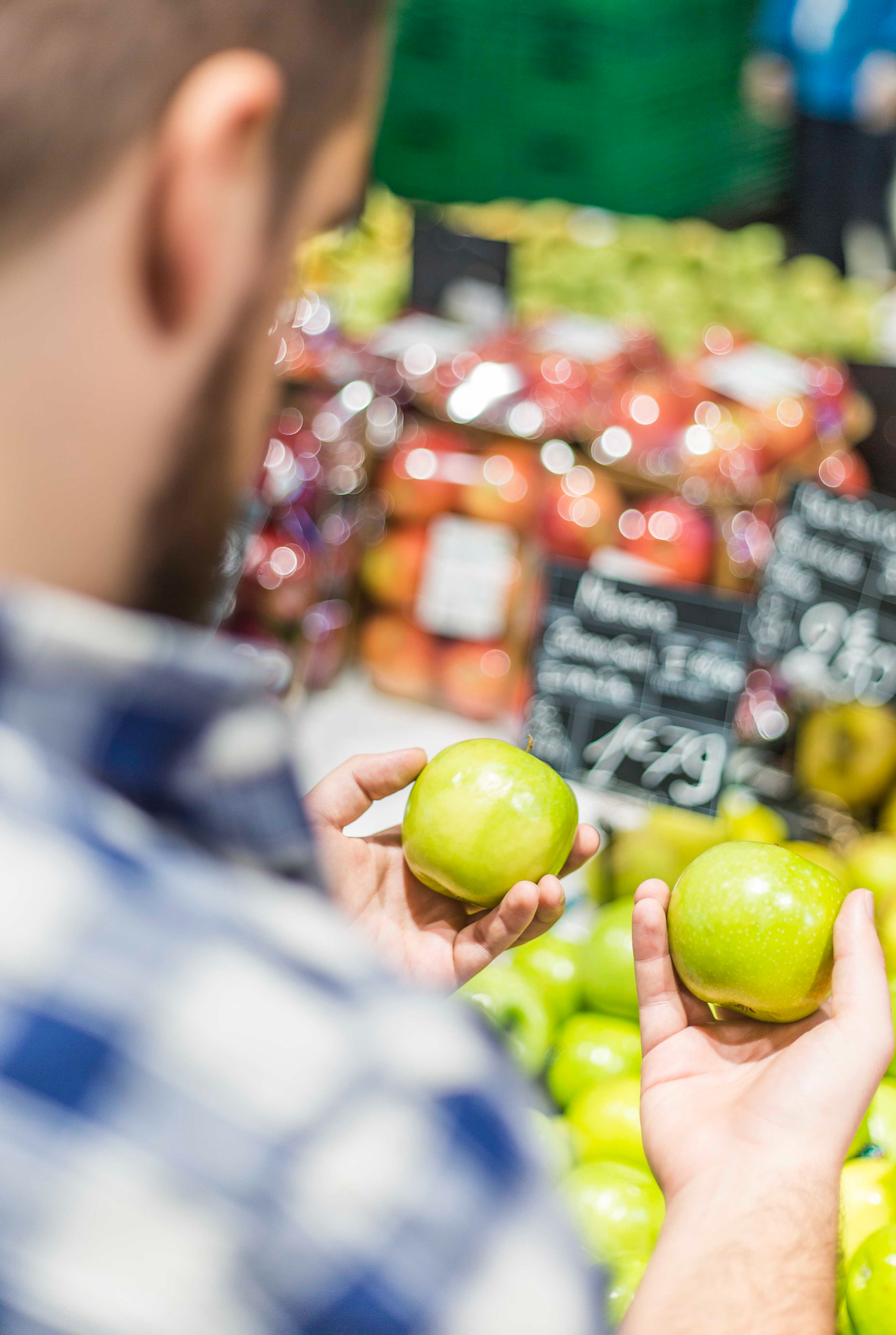Grocery shopping can make up a big portion of the weekly family budget and quite possibly one of your biggest expenses next to housing and child care. If you are not aware of your monthly grocery spend those supermarket trips can easily add up and blow out your budget. If you are keen to save money and make your income go further, reassessing your grocery budget can be a great place to start.
Don’t forget to give the Grocery Budget Challenge a go at the end of this post! 🙂
Here are 10 Easy Tips to Save Money on Your Groceries Budget that can help you plan ahead and that can quickly add up to some great and easy savings on your grocery bills.
1. Always bring a list with you and stick to it
Save money on groceries by having a shopping list on your fridge. This is my number one tip to save money on your groceries budget! When you are out of something, write it down and by the end of the week, you’ll have a list of things to buy that you actually use. Avoid walking into a supermarket unprepared! Once you are in the store, resist adding to this list with impulse purchases by completely avoiding aisles that don’t contain items on your list.
2. Resist buying large quantities of new products
Avoid buying new products or if you can’t resist, only buy one to try it out first and see if you like it to avoid ending up with multiple items that you may not like. We quickly learned that often new food or products we would buy on sale were more often than not left unused and taking up space in our pantry or cupboards. Sometimes it is best to stick to using our trusted and preferred brands of products to eliminate waste and save money!
3. Shop online to help resist impulse purchases
Do your grocery shop online when you can. It’s easy to see what products you regularly purchase are on sale and helps you streamline your grocery list. I grab my shopping list, sit down for ten minutes, and order what is on that list and pick it up at a convenient time or get it delivered. Not being in the store means you avoid the additional temptation to make unnecessary purchases and helps you stick to your budget.
4. Buy only what you need and avoid excessive bulk purchases
Don’t overstock on sale items. Just because something is on sale doesn’t mean you need to buy a year‘s supply of it! Most popular items go on sale on a rotating cycle every 3-5 weeks so you needn’t be preparing for the apocalypse! (2021 update: Then covid and panic buying hits’;))
Try and keep in mind how much you need when shopping to avoid wasting money on groceries you won’t end up using. I know that I can buy a large packet of carrots for only 50c more, but I always go for the smaller packet so they don’t end up in the bin, and I save myself the 50 cents. Alternatively, if you do buy a little bit extra, make sure you store the items correctly so they will last longer such as in a container or in your freezer.
5. Store food correctly to prolong life and reduce waste
Learn how to store food correctly in order to prolong its life. Some food such as potatoes and onions should be stored separately, tomatoes ripen better out of the fridge, and herbs and carrots thrown into a glass of water will last a few days longer than in the fridge. This will ensure you get as long out of your fresh produce as possible saving you another trip to the store and money.
Check out: How to Reduce Your Waste Footprint for more tips on how to reduce waste in your home!
6. Save with DIY Cleaning products
Reduce cleaning supply bills by making your own DIY cleaning products for a fraction of the price as well as limiting the cupboard overflowing with different products for each cleaning task. Bicarb, dishwashing liquid, water, and white vinegar alone can clean most areas of the home, as well as being safer to use inside the home. Cleaning products can contribute a huge portion of your grocery bills and can be a great way to save money on your groceries budget.
7. Switch to machine-washable cloths
Switching to machine-washable microfiber cloths can help save endless dollars on dishcloths. A pack of microfiber cloths can be obtained for $5-10 and can be washed again and again to save you from replacing cloths regularly. Simply use and put in a washcloth pile to wash once a week. Other savings tips for regular kitchen cloths is to soak them in vinegar and heat them in the microwave for a couple of minutes to kill bacteria or to throw them in your dishwasher cycle at least once a week.
8. Meal Plan
Meal Planning can be an easy way to save money on groceries. Base your shopping list on what meals you could make with the ingredients you currently have in your pantry or fridge. Add any additional ingredients required for those recipes to the shopping list. If you’re buying something that will not be used up in one meal, incorporate the leftovers into your next meal so you can avoid food waste or freeze the remaining portions where possible for next time.
Just ten minutes a week of meal planning can save you hundreds over the year and drastically help reduce food waste in your home.
Start saving money today with your Weekly Meal Planner Printable

9. Research specials online or in catalogues prior to entering the supermarket
Buying more expensive items such as beverages, beauty, and cleaning products can add up over time when paying full price. In order to easily save money on your groceries budget, check out the weekly catalogues for your local supermarkets.
Make separate lists for your groceries based on what you are planning to buy in each and shop according to what store has the best price. This might take a little longer, but the savings can be very much worth your while. If you do online shopping this can be even easier where you can just order from different stores and get pick up or home delivery to avoid multiple trips (but with the cost of delivery it might be more savvy to pick them up from the one shopping centre if possible).
Alternatively, go to the shop when it suits you, it doesn’t have to be on the same day, if you will be near one today and another on the weekend grab what you need when it is convenient.
10. Pay attention to the ticket pricing per weight
In Australia, supermarkets are now required to include easy price comparisons on their pricing tags such as price per 100 grams. You can now easily compare various sizes and prices of similar products from the price tag on the shelf. This can be done much quicker than before when you’d be trying to work these things out in your head or with your calculator and can be an easy quick way to decide in-store or online what is the best value for money product to buy.
Grocery Budget Challenge
If you like the idea of a challenge here is one for you!
I want you to calculate how much you have spent on groceries over the last 3 months, so your monthly grocery budget spend. The steps are below:
- Simply go through your bank or credit card statements and add up all amounts spent on groceries over the last 3 months (so working backward from today by 3 months) and total up how much you spent. If you want a more accurate figure, go back 6 months and total up the grocery spend.
- Divide the total grocery spend you calculated by 3 or 6 months (however many months you went back in your statements).
This will give you your average monthly spend on your grocery budget.
With the above 10 tips in mind and your average monthly spend amount, I then want you to try and decrease your average grocery budget from what you calculated by 10%. So if your grocery budget came to $700 a month on average, I want you to try and cut it down by 10% ($70 in this example).
See how you go! You might find that you can easily cut it by 10% or more, and can redirect those savings to another financial goal! And even if you can only save $10 a week on your groceries, that’s still a whipping $520 a year back in your pocket! How awesome is that?! 🙂
For more tips to save on your grocery budget check out 6 Tips to Drastically Cut Your Grocery Bill and 15 Tips to Reduce Food Waste and Save Money!
Do you have any tips to save money on your groceries budget? How did you go with the Grocery Budget Challenge? Leave a comment below to let me know! 🙂



